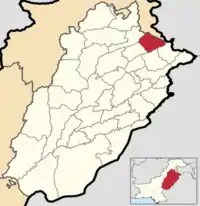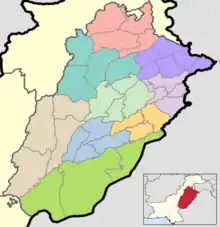Gujrat District
Gujrat (Punjabi and Urdu: ضِلع گُجرات), is a district of Punjab Province in Pakistan.
Gujrat | |
|---|---|
 Map of Gujrat District | |
| Country | |
| Province | Punjab |
| Division | Gujranwala Division |
| Headquarters | Gujrat |
| Government | |
| • Deputy Commissioner | Muhammad Saif Anwar Jappa |
| • District Police Officer | Umar Salamat |
| Area | |
| • Total | 3,192 km2 (1,232 sq mi) |
| Population (2017)[1] | |
| • Total | 2,756,110 |
| • Density | 860/km2 (2,200/sq mi) |
| Time zone | UTC+5 (PST) |
| Number of Tehsils | 4 |
It is bounded on the northeast by Mirpur, on the northwest by the River Jhelum, which separates it from Jhelum District, on the east and southeast by the Chenab River, separating it from the districts of Gujranwala and Sialkot, and on the west by Mandi Bahauddin. District Gujrat is spread over an area of 3,192 square kilometres.
History
Ancient history
According to the British Imperial Gazetteer:
Gujrat town itself is a place of some antiquity, and the district bounds in ancient sites.The region was conquered by Chandragupta Maurya. It remained under the Mauryas for few hundred years until shortly after the death of Ashoka in 231, and about forty years later came under the sway of Demetrius the Graeco-Bactrian. The overthrow of the Bactrians by the Parthians in the latter half of the second century brought another change of rulers, and the coins of the Indo-Parthian Maues (c. 120 B. c.), who is known to local tradition as Raja Moga, have been found at Mong. At the end of the first century A. D., ie whole of the Punjab was conquered by the Yueh-chi. For several hundred years nothing is known of the history of the District, except that between 455 and 540 it must have been exposed to the ravages of the White Huns. Dr. Stein holds that the District formed part of the kingdom of Gurjara, which, according to the Rajatarangini, was invaded between 883 and 902 by Sankara Varman of Kashmir, who defeated its king Alakana.[2]
However the foundation of the capital, Gujrat, according to the Ancient Geography of India:
is ascribed to a king named Bachan Pal of whom nothing more is known; and its restoration is attributed to Alakhana, the Maha Raja of Gurjara, who was defeated by Sangkara Varmma between AD 883 AD 901.[3]
Islamic Rule (Ghaznavid, Ghurid, Delhi, Suri and Mughal Empires)
In 997 CE, Mahmud Ghaznavi, took rule over the Ghaznavid dynasty established by his father Sebuktegin. After defeating the Hindu Shahis, he conquered their kingdom entirely which included the Punjab region of modern day Pakistan.
After defeating the Ghaznavids, the Ghurids succeeded them who were then replaced by the Delhi Sultanate.
The Mughal emperor Akbar established Gujrat as a district along with many others when he began consolidating his rule over his vast empire. Jahangir, Akbars son and successor, in his memoirs records the following information on Gujrat:
At the time when His Majesty Akbar went to Kashmir, a fort had been built on the bank of that river. Having brought to this fort a body of Gujars who had passed their time in the neighbourhood in thieving and highway robbery, he established them here. As it had become the abode of Gujars, he made it a separate pargana, and gave it the name of Gujrat. "[4]
The settlement of the tract was completed by Akbar, who built a fort and compelled the Gujars to settle in it. The tract was then named Gujrat and formed into a separate district. Revenue records have been preserved in the families of the hereditary registrars (kanungos), and these exhibit Gujrat the capital of a district containing 2,592 villages, paying a revenue of 11.6 million. In 1605 the famous Sayyid Abdul Kasim received Gujrat as a fief from Akbar.
After Aurangzebs death in 1707, Mughal power declined. Nadir Shah occupied the district of Gujrat during his invasion of the Mughal Empire in 1739. Shortly afterwards in 1741, the city was captured by Punjabi Gakhar tribesmen from near the Rawalpindi area.
The district and Punjab as a whole was devastated even further from the invasions and raids of the Durrani Afghans (Pashtuns) between 1747 and 1772 under their newly appointed ruler Ahmad Shah Durrani who frequently crossed and recrossed the area for plunder and battling the newly emerged Sikh Misls for control of the region following the power vacuum left by the Mughals.[2]
Sikh and British era
By 1765, the Sikhs had eventually won out against the Durranis for control in the area of Gujrat when the Sikh Bhangi Misl under Gujjar Singh overran the area defeating the local Punjabi Ghakhars under Muqqarab Khan. The Sikhs defeated an invasion of an Afghan force for Gujrat on 29 April 1797.
In 1798, the Bhangi leader Sahib Singh pledged allegiance to the Sukerchakia Misl of Ranjit Singh. By 1810, Ranjit Singh's armies captured the city from Bhangi forces, thereby extending the rule of the Sikh Empire to the city.
The Sikh empire declined following Ranjit Singh’s death in 1839. The British East Indian Company defeated the Sikhs between 1845-1846 during the First Anglo-Sikh War reducing their power significantly. Two years later, the empire collapsed after the British EIC again decisively defeated the Sikhs at the Battle of Gujrat thus ending the Second Anglo-Sikh War. The Sikh empire was entirely annexed and incorporated into the rule of the British EIC.[2]
Language and demography
According to 2017 census the population of the district has reached to 2,756,110 of which 1,335,339 are males and 1,420,628 are females. This census shows that 1,928,714 persons live in rural while 827,396 live in urban areas. It is further reported that there are 143 transgenders.[5]
The predominant language of the district is Punjabi, which according to the 1998 census is the first language[6] of 98% of the population, while Urdu accounts for 1.1%.[7]
Administration
The district is administratively subdivided into three tehsils, these are:
Education
District Gujrat has a total of 1,475 government schools at primary and secondary level.[8] Out of these public schools, 60 percent (889 schools) are for girls. According to the latest available data, 323,058 students are enrolled in the public schools while 10,581 teachers are working in these schools.
Notable people
Politicians
- Aitzaz Ahsan, Pakistani barrister
- Fazal Ilahi Chaudhry, President of Pakistan 1972–1977
- Chaudhry Pervaiz Elahi, former Chief Minister of Punjab & Federal Minister, Speaker of Provincial Assembly of Punjab (from 16 August 2018 to present & from 1997 – June 2001).
- Chaudhry Zahoor Elahi, politician
- Moonis Elahi, former MPA (2008-May2018) and Current MNA (Oct 2018 to present) of Gujrat
- Chaudhry Muhammed Farooq, former law minister
- Nawabzada Ghazanfar Ali Gul, former Federal Minister of Pakistan
- Mian Muhammad Afzal Hayat, former Chief Minister of Punjab and served as ambassador in different countries
- Shujaat Hussain, former 16th Prime Minister of Pakistan on a temporary basis (30 June 2004 to 28 Aug 20014)
- Chaudhry Jaffar Iqbal, Vice-President of PML-N Punjab
- Qamar Zaman Kaira, former Federal Minister of Pakistan
- Mian Imran Masood, former MPA of Gujrat and Minister of Education Punjab.
- Ahmad Mukhtar, Former Minister For Defence Government of Pakistan
- Yasmin Qureshi, British MP
Scholars
Military
- Major Muhammad Akram, Nishan-e-Haider
- Major Raja Aziz Bhatti, Nishan-e-Haider
- Mohammad Shariff, Pakistan Navy Chief of Naval Staff and Chairman Joint Chiefs of Staff Committee
- General Raheel Sharif, is a four-star rank army general, served as the 15th Chief of Army Staff of the Pakistan Army
- Major Shabbir Sharif, Nishan-e-Haider
Poets
- Orya Maqbool Jan, writer, columnist, analyst, former civil servant and poet
- Shareef Kunjahi, leading writer and poet of the Punjabi language
- Anwar Masood, poet
- Krishna Sobti, Hindi Writer
- Fakhar Zaman, writer and poet
Sport
- Tanwir Afzal, Hong Kong cricketer.
- Imtiaz Bhatti, Pakistani cyclist and a former Air Force pilot of Pakistan.
- Mudassar Bukhari. Dutch cricketer.
- Rizwan Cheema, Pakistani Canadian cricketer.
- Munir Dar, Hong Kong cricketer.
Actors/Actresses
- Inayat Hussain Bhatti, film director and actor
- Ejaz Durrani, actor
- Shagufta Ejaz, actress
- Sabiha Khanum, actress
Musicians
- Adeel Chaudhry, also a dentist, actor and model
- Alam Lohar, Punjabi folk singer
- Arif Lohar, Punjabi folk singer
- Zoe Viccaji, Pakistani singer-songwriter and musical actress
Other
- The family of UK-born Shafilea Ahmed, an honour killing victim, originated from Uttam.[13]
References
- "DISTRICT WISE CENSUS RESULTS CENSUS 2017" (PDF). www.pbscensus.gov.pk. Archived from the original (PDF) on 29 August 2017.
- Imperial Gazetteer of India, v. 12, p. 366
- The Ancient Geography of India, page 151, Alexander Cunningham
- The Memoirs of Jahangueir (Rogers), Volume 1, chpt. 23
- Archived 2006-05-13 at the Wayback Machine
- "Mother tongue", defined as the language of communication between parents and children.
- 1998 District Census report of Gujrat. Census publication. 101. Islamabad: Population Census Organization, Statistics Division, Government of Pakistan. 2000. pp. 29–30.
- "Punjab Annual Schools Census Data 2014-15". Archived from the original on 19 August 2016. Retrieved 19 August 2016.
- "Qasim Ali Shah". Retrieved 25 January 2021.
- folder.pk. "About Qasim Ali Shah: | Biography,". folder.pk. Retrieved 25 January 2021.
- "Qasim Ali Shah Biography - Popular Motivational Speaker, Trainer and Writer". Folder. 25 October 2017. Retrieved 25 January 2021.
- "10 Qasim Ali Shah Books ideas | books, motivational books, books free download pdf". Pinterest. Retrieved 25 January 2021.
- Crilly, Rob (3 August 2012). "The Pakistan village where Shafilea drank bleach to avoid an arranged marriage". The Telegraph. Retrieved 26 December 2019.
External links
| Wikivoyage has a travel guide for Gujrat District. |
